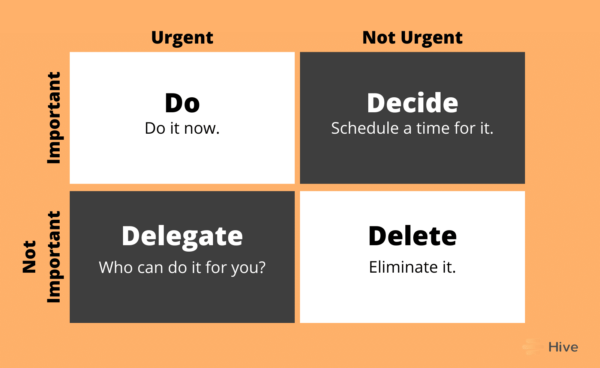Focusing on the wrong things at work can happen to the best of us. It’s a human tendency: Even with good intentions, if you don’t actively and intentionally prioritize, it’s easy to lose sight of the bigger picture. Enter the Eisenhower matrix, a very simple task-prioritization tool that can revolutionize your project management efforts.
“The Eisenhower matrix is perhaps one of the best project and time-management tools out there. It is so easy to use, and it provides immense clarity to your to-dos and workload,” says Jacob Udodov, founder and CEO of Bordio, a project and task-management platform.
What is the Eisenhower matrix?
The Eisenhower matrix is divided into four quadrants: two rows and two columns. Urgent versus not-urgent tasks, and important versus not important tasks. A task may be timely but not important to the goals of a team. Say, for example, that a section of your website is down. You do need to fix the issue ASAP, but that will take time away from working on projects to meet your monthly targets.
Important and timely tasks are obviously top priority, and anything not important and not urgent needs to be questioned. “The matrix suggests dividing all tasks into four categories based on their urgency and importance. Naturally, urgent and important tasks have to be dealt with immediately. As for non-urgent and non-important, these need to be either delegated or dropped altogether,” says Udodov.
The framework was inspired by former U.S. president and military officer Dwight D. Eisenhower. Author Stephen Covey used his decision-making insights and repackaged them into a matrix in his famous book, “The 7 Habits of Highly Effective People.”
What to do with each type of task
Urgent & important
Do it ASAP: Urgent tasks that are left unattended have consequences, so this will need your immediate attention.
Urgent & not important
Address it soon: Schedule a time when you will tackle this action item–it’s too easy to procrastinate on it otherwise.
Not urgent & important
Delegate it: This still needs to get done, but it doesn’t have to get done by you.
Not urgent & not important
Ditch it: Feel free to remove this from your to-do list and don’t waste anyone else’s time with it.
Benefits of the Eisenhower matrix
“The matrix works so well for many people because it gives a visual overview of and a simple structure to what needs to be done. Often, we procrastinate because we feel overwhelmed, or get swamped by insignificant work and miss out on strategic improvements. The matrix targets those notorious issues in a fun and easy form,” he adds.
“Who can define for us with accuracy the difference between the long and short term! Especially whenever our affairs seem to be in crisis, we are almost compelled to give our first attention to the urgent present rather than to the important future,” once said Eisenhower himself.
Here are some of the benefits of using the Eisenhower matrix.
Say goodbye to busywork
Work for the sake of work is a productivity killer. The Eisenhower matrix is a simple, visual way to revisit your priorities on a regular basis and identify where you’re spending efforts on activities that don’t move the needle towards your bigger goals.
Increased focus means more impact
Refining your priorities and dropping some deliverables from your to-do list means that you have more energy to channel towards your top priorities. This focus translates into bigger impact and results.
Avoid the trap of putting out fires all the time
The Eisenhower matrix also allows you to assess how you tend to spend your time. If most of your tasks fall into the “urgent” category, it could be a sign that you’re stuck putting out fires all the time at the expense of other important duties. You want to be proactive, not reactive, so noticing and blocking off time for important tasks that are not crises is key.
Become a better delegator
The framework can also help you become a better delegator, as it will encourage you to ditch tasks that are not urgent nor important altogether or to delegate some of the ones that still need to get done.
Save time and money
You know what they say: time is money. By encouraging regular prioritization, the Eisenhower matrix helps you save precious resources–especially when you repeat the exercise over the course of a quarter or a year.




